Godzilla Vs Megaguirus (2000)
Directed by: Masaaki Tezuka
Written by: Hiroshi Kashiwabara, Wataru Mimura
Starring: Masatô Ibu, Misato Tanaka, Shôsuke Tanihara, Yuriko Hoshi
HCF REWIND NO. 200: GODZILLA VS MEGAGUIRUS AKA GOJIRA TAI MEGAGIRASU: JI SHIMETSY SAKUSEN, GODZILLA VS MEGAGUIRUS: THE G ELIMINATION PROJECT WAR [Japan 2000]
AVAILABLE ON DVD
FEATURED MONSTERS: GODZILLA, MEGANULONS, MEGAGUIRUS
RUNNING TIME: 106 min
REVIEWED BY: Dr Lenera, Official HCF Critic
After Godzilla has attacked Japan in 1954 and 1966, the Japanese government decides to shut down nuclear energy, it having been a major target for Godzilla, and run the country on wind and sunlight. In 1996, an institute is allowed to study sources of clean energy, and creates the plasma energy generator, but Godzilla appears to destroy it. In 2001, Kiriko Tsujumori, one of the soldiers who battled Godzilla in 1996, and out for revenge for the deaths of most of her group, is the commander of G-Grasper, an anti-Godzilla organisation. She enlists disgraced inventor Hajime Kudo to help her create the Dimension Tide, a black hole which can fire miniature black holes. However, the first demonstration opens a wormhole through which a prehistoric dragonfly enters the present and deposits a single egg before exiting through the wormhole. A boy finds the egg and takes it with him when he moves to Tokyo….
Godzilla Vs Megaguirus tends to be one of the least regarded of the films in the Millennium Godzilla films amongst fans, but I fail to understand why. It does have a tendency to rehash elements from films in the Heisei series [the series that preceded the Millennium series, the first Godzilla series was called the Showa series], and doesn’t always make the most of its more original ideas, but it’s a full-on action-packed spectacle that is an enormous improvement on Godzilla 2000. It can’t quite seem to decide what sort of Godzilla film it is, the overall tone being quite serious but with some extremely silly scenes, but I remember when I first saw this one being overjoyed to see the return of certain goofy 60’s and 70’s elements, most notably the fight scenes which have a vigour and physicality as well as, yes, silliness to them [but it’s good silliness in my view: I’ve never understood some fans who enjoy the more humorous Godzilla movies but want the new pictures to take everything seriously] unseen since 1975. This is also the sort of film where, for instance, scientists think nothing of the consequences of shooting black holes from space towards earth. The special effects fluctuate in quality almost as much as the ones in the previous film, but the good ones outweigh the bad ones. Overall this is a highly entertaining Godzilla that I feel should have received a US theatrical release instead of the lacklustre Godzilla 2000: it delivers far more of what you want from a Godzilla picture [for a start, Godzilla doesn’t disappear from the middle half of the film] and may have done considerably better at the American box office.
Plans for the next Godzilla film had began even before Godzilla 2000 was released, but Godzilla 2000 was a commercial failure in Japan so Toho replaced most of its creative personnel, though kept writers Wataru Mimura and Hiroshi Kashiwabara and special effects director Kenji Suzuki. Unfortunately, they also cut the budget and director Masaaki Tezuka had to also deal with a rushed production schedule. Toho wanted to make amends for the previous film and show people what a Godzilla film should be like, but it seems to me that they didn’t give this film the care and time it needed, so it’s amazing that it came out as good as it did. The original script referred back to Rodan, the 1957 film that introduced the huge flying pterosaur of the same name, though the second draft eliminated the references except for containing the same monsters that appeared before Rodan in that film: the Meganuron, except that they looked very different. Godzilla Vs Megaguirus made even less money than its predecessor, it selling the least amount of tickets since 1975’s Terror Of Mechagodzilla, though some have said that this was partly because so many had been disappointed by Godzilla 2000. Though Toho prepared an English-dubbed version, Tri-Star opted not to give it a US theatrical release after the poor performance of Godzilla 2000 [though a cursory amount of research on the subject indicated that it didn’t do badly considering it didn’t get too wide a release], though Godzilla Vs Megaguirus did become the first Godzilla film to receive an uncut, Japanese-language release first time round for home viewing.
Now this film is rather confusing at first, and it really helps if you accept that, for the most part, none of the Millennium films even attempt to exist in a chronological order or connect with each other. Instead, with two exceptions, they take place in their own universes which only occasionally link back to older Godzilla films. I’ve never liked this about the Millennium series: sure, it allows each film more freedom, but it also comes across as lazy and the individual pictures don’t register so much as an actual series. This one does open with black and white footage from Godzilla, though some shots are recreated because the 2000 Godzilla looks quite different from the 1954 one. The effect is weird and for the next few minutes we have to take in a hell of a lot of information, some of which totally contradicts older films [Godzilla attacks in 1966? He was on his way to becoming earth’s defender then!], and some of which would have better given to us as background later on, though the commentary on energy policy, Japan stopping nuclear energy because it attracts Godzilla but having to create it anyway, is interesting. Then we have a kick-ass action scene when Godzilla attacks in 1996, though the military group fighting him obviously has budgetary issues, seeming to just have bazookas which they fire at his kneecaps [yeah, that won’t make him angry]. The sequence is very well put together though, the editing is tight, the music exciting, and some of the effects shot startling, like a flaming car being hurled across a street before Godzilla is properly seen.
We then move on to 2000 and for a bit we do seem to be watching a Heisei rehash. The inventor hero Hajime Kudo is very much like the one in Godzilla Vs Destroyer with a bit of the goofiness of the one in GodzillaVs Mechagodzilla, and his recruitment to fighting Godzilla also very similar, while the Kiriko Tsujumori is just a female version of the vengeful soldier in Godzilla Vs Mechagodzilla. There’s a bit of dull techy chat, but things soon get more interesting with the cute boy Jun who is stupidly allowed to have a mysterious egg by Kiriko and throws it into a Tokyo sewer [so between them, Jun and Kiriko are partly responsible for the resulting trouble]. There’s a rather dark atmosphere, with a creepy shot of a monstrous shadow flying around seen through Jun’s window, and even a pretty gruesome kill, though it’s too quickly cut for us to see the details. Then Tokyo is flooded, and unfortunately we don’t see the flooding. In fact, this part really does seem to suffer from the lowering of the budget and appears unfinished. People on boats look up to a skyscraper and see the frightening sight of hundreds of big dragon-flies waiting there, but the resulting action seems to be cut off suddenly. Godzilla soon appears to battle the insects in a scene which seems inspired by one in Gamera 2: The Attack Of Legion but has great technical work, and the humans with their Dimension Tide and special plane the Griffin achieve little as it all climaxes with, of course, Godzilla fighting one huge creature. This fight is tremendously entertaining and has some Showa-style absurdity like Godzilla doing a body slam from a great height on his opponent: a shot from below of him falling towards the camera is hilarious, and you should see the expression on the other monster’s face. It also takes place during the day, the tendency having been to show fights at night as it can cover up more technical work, and Godzilla has to think strategically on how to best his opponent: brute strength and firing of his breath aren’t enough. There are some strange frame rate issues during the fight though.
The Godzilla suit is the same as before, stiff and unwieldy, and Godzilla’s underwater scenes done with CGI. The Meganulon are also mostly CGI and pretty unconvincing except during their battle with Godzilla where models shots are carefully cut in, and the Meganuron puppet just doesn’t create much awe and seem like a worthy opponent for Godzilla. He’s like a skinnier Battra [from Godzilla Vs Mothra], and Battra was cool, but you can see Meganuron’s strings in some shots. They could have easily been digitised out. The black holes look crap too, but at least the matting is generally excellent throughout and Godzilla [and Meganuron: he gets a brief but awesome destruction scene when he first cuts through some buildings with his wings, then reduces more to rubble by waving his wings a la Rodan] is back to destroying models this time. There is one terrific shot where we see Kiriko hanging on to part of Godzilla’s back [part of another wonderfully ridiculous scene this] and the camera pans out to reveal all of the monster. Director Masaaki Tezuka and cinematographer Shinichi Fushima do a fine job throughout, especially in the final battle with near-perfect use of close-ups, long-shots and a few POV angles. Every scene is tightly edited yet is still allowed to breath, and most of the human characters – I haven’t yet mentioned the corrupt bureaucrat or the two wise scientists – are unoriginal, but they do feel like real people and generally aren’t as black and white as usual in these films. Sadly their dialogue is often very poor on the R1 DVD, which uses dubtitles [copying the English dub] rather than properly translated subtitles. “You’re going to make Godzilla disappear into his own butthole!” says someone at one moment. The almost-romance of constantly-uptight Kiriko and Hajime is nice, if low-key, and is resolved in a freeze-frame [a device Tezuka clearly loves, as he uses it several times] which finishes the film [though there’s also a pointless extra scene after the end-credits].
The acting is mostly decent rather than great though it’s nice to see Yuriko Hoshi from Mothra Vs Godzilla and Ghidorah The Three-Headed Monster return as a second vengeful woman, and young Suzuki Hiroyuki, playing Jun, really is cute. The score by newcomer Michiru Ohshima is very good. A bit like the previous film’s score but better, its Godzilla theme doesn’t really convey enough strength but is quite memorable, and there’s some great musical backing to the Meganuron, quite eerie and atmospheric at times. Megaguirus has a catchy Spanish-flavoured theme which evokes memories of Masaro Sato’s fun scoring. The theme for the Griffin though sounds like the middle portion of John Williams’ Indiana Jones theme, and the music isn’t mixed quite loud enough, though this film’s aural mix is far better than Godzilla 2000’s. Of course Akira Ifukube’s Godzilla theme appear for one scene. I think that if Godzilla Vs Megaguirus had been given more money and time to make, it could have resulted in one of the best Godzilla film ever. As it stands, it’s very good, if often ridiculous, monster movie escapism. Toho may not have restored Godzilla’s box office allure with it, but certainly proved that they still had it in them to make a hugely fun Godzilla movie worthy of the monster’s name.


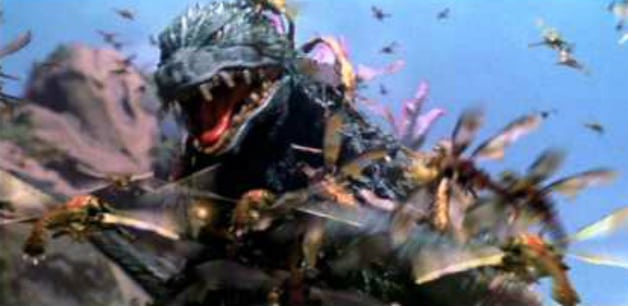
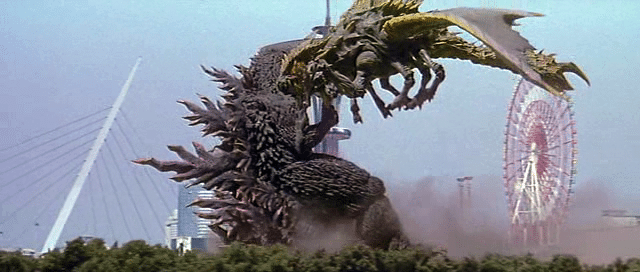



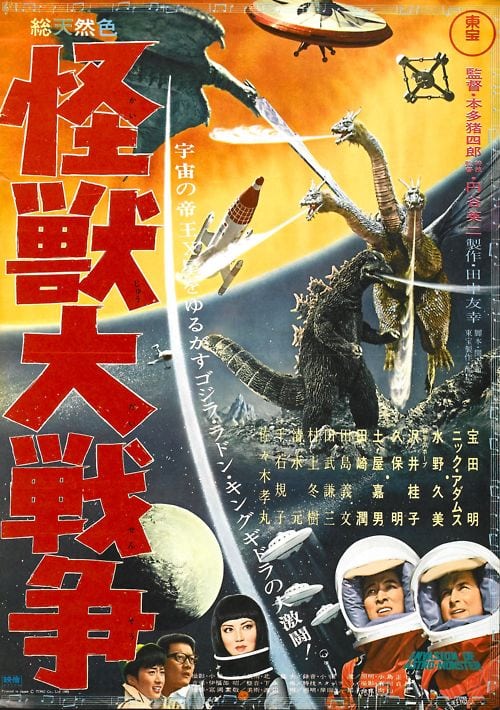
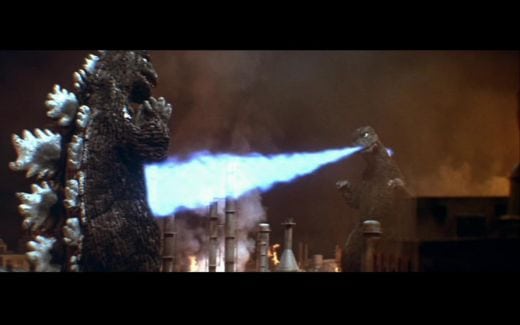
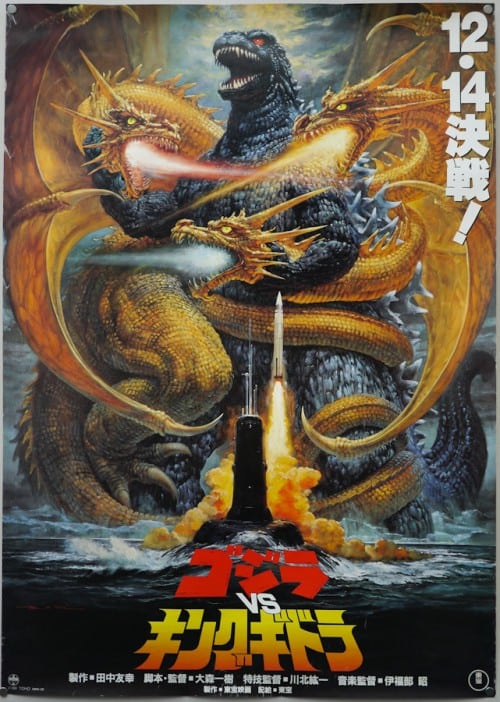
Be the first to comment